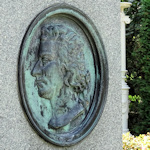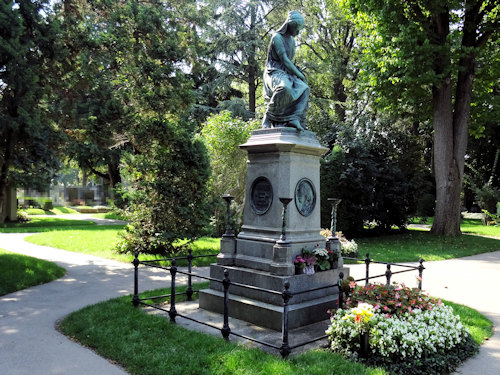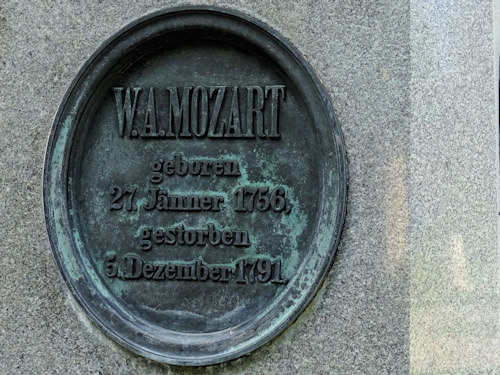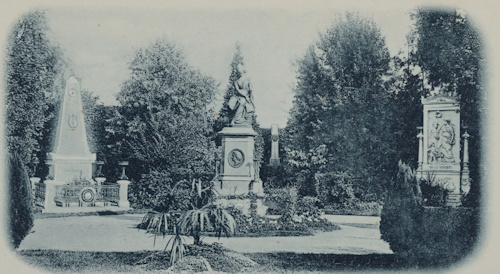
Some of the world’s great composers share the same leafy grove in Vienna’s main cemetery (the Zentralfriedhof), but Mozart remains one notable omission.
So what do you do when you have a hole (literally and figuratively) in your collection of honorary graves? You put up a memorial, instead.
- 1859 stone memorial originally built to mark Mozart’s burial site in St. Marx cemetery
- Located next to Beethoven and Schubert’s graves
- Book a classical concert experience* for Vienna
- See also:
The memorial

(Looks like a gravestone. Is a gravestone. Not, though, a grave.)
A bit of mystery surrounds Mozart’s grave. But we do know two things: roughly where it is and that he’s no longer in it (they reused burial plots back in those days).
Nobody knows for certain where the Salzburg-born composer’s bones ended up, but back in 1859 they at least erected a memorial at the best-guess location for the original burial site in Vienna’s St. Marx cemetery (which you can visit).
A few years after that, the city built a large, new cemetery (the Zentralfriedhof) some way from the centre and began adding famous graves to give it a popularity boost.

(The inscription on the side of the memorial simply gives his name and the dates of his life)
They busily dug up many of Vienna’s favourite musical sons to create a cluster of composer graves that now includes Beethoven, Brahms, Johann Strauss II, Schubert, and many others.
But not Mozart.
The grave of perhaps the world’s greatest-ever composer remained undisturbed, given its lack of, well, a Mozart inside.
Yet it didn’t seem quite right: all those composers honoured at the Zentralfriedhof, but the most famous of all a notable absentee. Hence the obvious compromise solution…

(The memorial at its original site in the St. Marx cemetery, as photographed by Josef Mutterer sometime before 1891; Wien Museum Inv.-Nr. 42241; excerpt reproduced with permission under the terms of the CC0 licence)
In 1891, one hundred years after his death, Mozart’s graveside memorial moved from St. Marx to join the composer’s musical colleagues and successors at the Zentralfriedhof.
The memorial features a grieving muse as well as Mozart’s portrait in relief. Even today, it’s not unusual to find flowers left there by well-wishers.
The memorial’s creator was Hanns Gasser, whose various sculptures can still be seen around the city today. Some have their own particular link to the great composer.

(Image from an 1898 postcard picturing the “honorary graves” of Beethoven, Gluck, Mozart and Schubert; produced by Carl (Karl) Ledermann jun.; Wien Museum Inv.-Nr. 17788/577; excerpt reproduced with permission under the terms of the CC0 licence)
Gasser helped decorate, for example, the main altar at the Waisenhauskirche, the very church where a 12-year-old Mozart once conducted a performance of the Mass in C minor (the “Waisenhausmesse”) he wrote for the church’s consecration.
Gasser also produced sculptures for fountains outside the 1869 State Opera House, which has hosted, for example, over a thousand performances of Mozart’s The Marriage of Figaro.
How to get to the Mozart memorial
For directions to the cemetery, see the main Zentralfriedhof article. Once inside, follow the directions for Beethoven’s grave: Mozart’s memorial sits just in front of Beethoven’s last resting place (no coincidence, I think).
If travelling out to the Zentralfriedhof seems a bit of a chore, then Vienna also has a more central memorial to this giant of classical music. The famous Mozart monument lives in the Burggarten park next to the Hofburg complex.
Address: Zentralfriedhof, Simmeringer Hauptstraße 234, 1110 Vienna